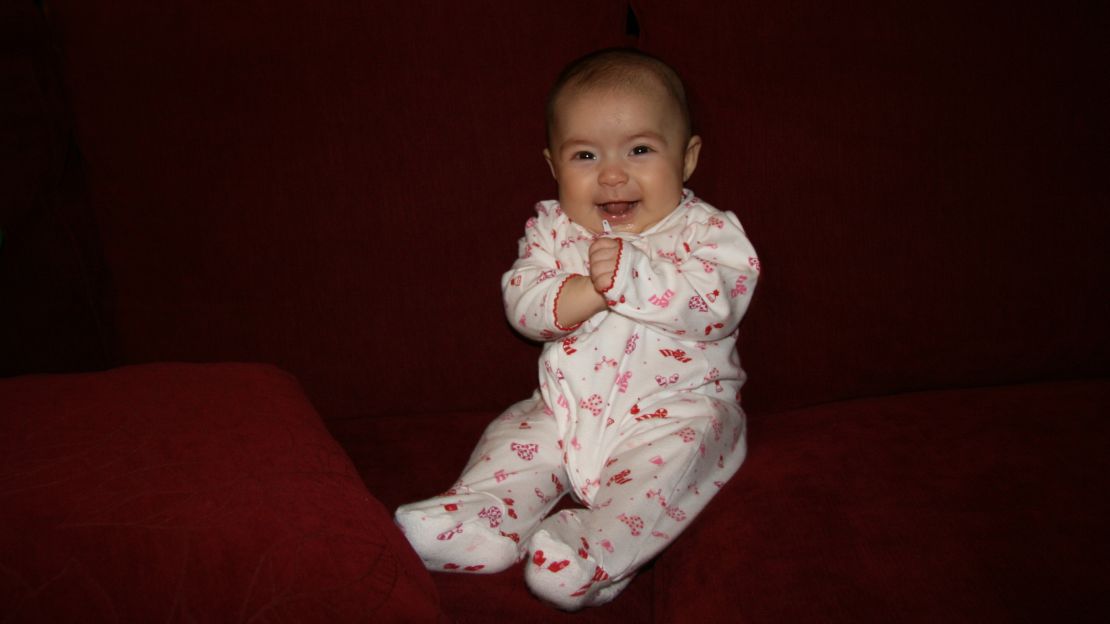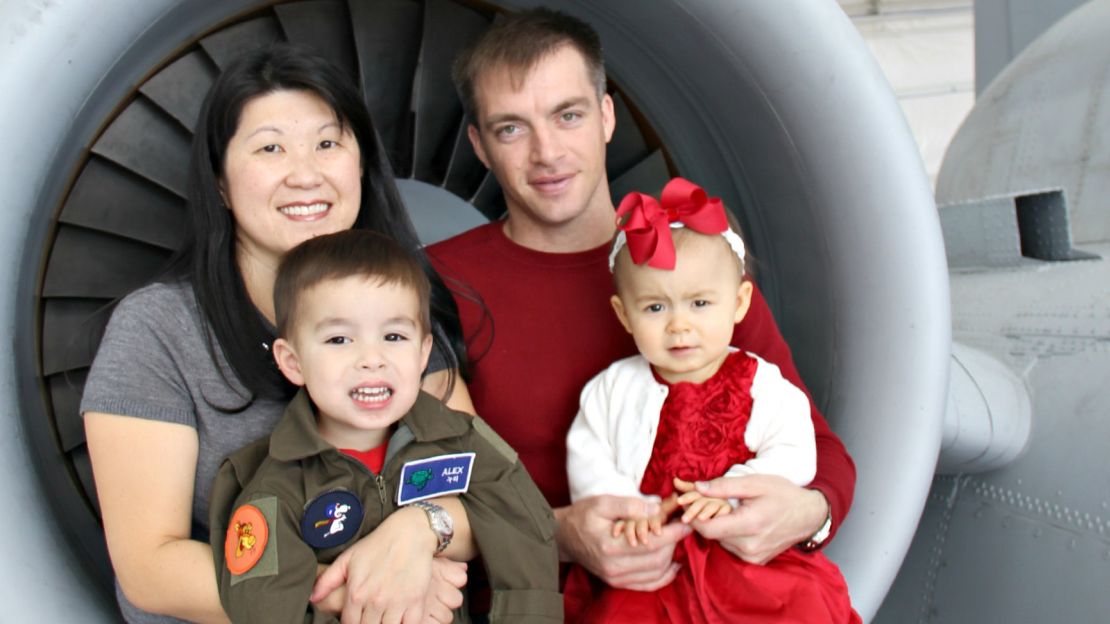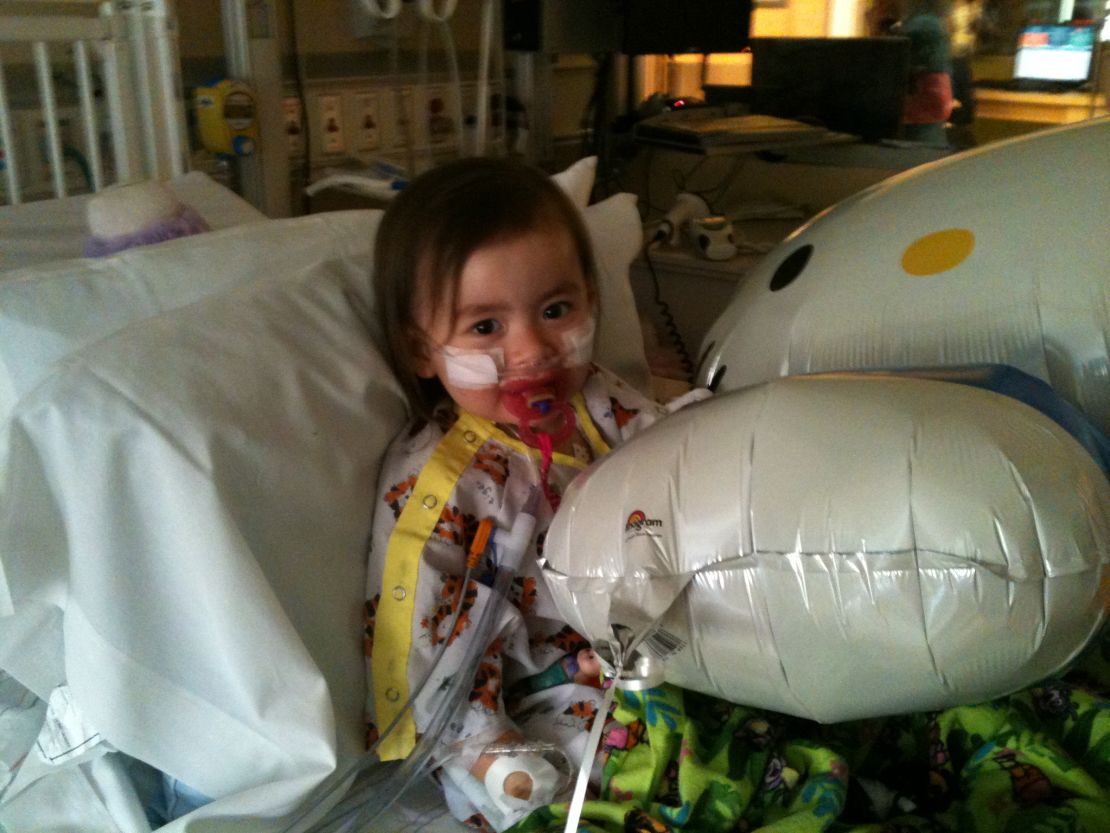This is the first part of the series,”Heaven over hospital.” Read the second part here.
Story highlights
Julianna Snow, 5, is dying from a rare neurodegenerative illness
Her parents asked her if she wants to go back for more treatments at the hospital, or does she want to die at home
Michelle: Julianna, if you get sick again, do you want to go to the hospital again or stay home?
Julianna: Not the hospital.
Michelle: Even if that means that you will go to heaven if you stay home?
Julianna: Yes.
Michelle: And you know that mommy and daddy won’t come with you right away? You’ll go by yourself first.
Julianna: Don’t worry. God will take care of me.
Michelle: And if you go to the hospital, it may help you get better and let you come home again and spend more time with us. I need to make sure that you understand that. Hospital may let you have more time with mommy and daddy.
Julianna: I understand.
Michelle: (crying) - I’m sorry, Julianna. I know you don’t like it when I cry. It’s just that I will miss you so much.
Julianna: That’s OK. God will take care of me. He’s in my heart.
Excerpt from Michelle Moon’s blog.
A child decides: Heaven or hospital?
Julianna Snow is dying of an incurable disease. She’s stable at the moment, but any germ that comes her way, even just the common cold virus, could kill her. She’s told her parents that the next time this happens, she wants to die at home instead of going to the hospital for treatment.
If Julianna were an adult, there would be no debate about her case: She would get to decide when to say “enough” to medical care and be allowed to die.
But Julianna is 5 years old. Should her parents have let her know how grave her situation is? Should they have asked her about her end-of-life wishes? And now that those wishes are known, should her parents heed them?
Missing milestones, and a medical mystery
When she was 9 months old, Julianna’s parents noticed she couldn’t sit up steadily, something most babies can do around 6 months. At her first birthday, when children typically start to walk, Julianna couldn’t even pull herself up into a standing position.

This worried Michelle Moon, as a mother and as a neurologist. “The worst thing in the world for a neurologist is to not hit your milestones,” she says. “But I tried really hard not to overreact and freak out.”
Julianna’s pediatrician said she was likely just a late walker and would catch up soon. Five percent of children, he noted, don’t walk until they’re 18 months old.
Michelle wanted to believe him, but her mother’s intuition, or perhaps her neurologist’s training, told her this was something more worrisome. She set out to do her own research, which was lonely work, because her husband, Steve Snow, an Air Force pilot, was on a three-month deployment to Korea.
With Julianna’s symptoms – her developmental delays and her somewhat floppy arms and legs – this is what kept popping up: spinal muscular atrophy, a hereditary disease where neurons in the brain and spinal cord are progressively destroyed. Many children with the disease don’t live to see their second birthday.
To get spinal muscular atrophy, a child must inherit a defective gene from both parents. Michelle had herself tested and didn’t have the gene. She was relieved, but stumped. By now Julianna was 1½ and couldn’t walk without the help of a walker, and then only for short distances. Her doctors were mystified, too.
Then Michelle remembered her husband’s funny-looking feet.
A diagnosis, inherited
In spring 2004, after flying fighter jets over Baghdad and Kuwait, Air Force Capt. Steve Snow was assigned to Osan Air Base in South Korea. On his first day, not knowing a soul, he headed to the officers’ club in search of company.
That’s when she walked in: Capt. Michelle Moon, the flight surgeon for his squadron.
Michelle expected Steve to be wary of her, as pilots often don’t trust the doctors who have the power to ground them. But unlike some other pilots she’d met, Steve was friendly. As they got to know each other, she found him dependable and trustworthy. She sensed in him, she says, a genuine goodness.
The two fell in love and were married in 2006. Two years later, their son Alex was born, and Julianna came along two years after that on August 25, 2010.
Over the years, Michelle had never given her husband’s feet much thought, except to occasionally notice that they were sort of odd looking, with high arches.
But as Michelle searched for the cause of their daughter’s slow development, Steve’s funny-looking feet became the key to solving their daughter’s mystery.
High arches, Michelle remembered, can sometimes be a sign of Charcot-Marie-Tooth disease, a neurodegenerative illness awkwardly named for the French and British doctors who discovered it nearly 130 years ago.
Poor reflexes can be a sign, too, so Michelle took her reflex hammer to her husband’s Achilles tendon. His foot should have responded with a little jerk. But it didn’t move at all. “I thought, uh-oh. You can not have reflexes at 60 or 70, but in your mid-30s?” she remembers.
Michelle brought her husband into her office during lunch hour and attached electrodes to his arms and legs. She found his nerves were slow at sending impulses to his muscles. Another neurologist confirmed her findings and diagnosed Steve with CMT.

At first it seemed unbelievable – Steve had been athletic his entire life and now flew fighter jets for a living. Countless doctors had examined him over the years for flight physicals. How could he possibly have nerve damage in his arms and legs? But CMT can sometimes be so mild that it goes unnoticed, even by the person who has it and the doctors examining him.
By some awful quirk of genetics, Steve’s mild case of CMT had manifested as a severe case in his daughter.
In fall 2012, just after Julianna turned 2, Steve and Michelle brought her to the University of Iowa to see Dr. Michael Shy, one of the world’s leading experts on CMT. He explained that the myelin sheath covering her nerves had never formed correctly, and so underneath, her nerves were degenerating, as a wire frays if the insulation around it breaks down.
The severity of CMT depends on the specific genetic mutation that has caused it. Shy tested Julianna and couldn’t find anything amiss, so he sent her DNA to a specialized genetics lab at the University of Miami for a wider search. They couldn’t find anything definitive, either.
This didn’t mean Julianna didn’t have CMT; scientists just haven’t discovered her particular variation. Without knowing what genetic mutation was causing her disease, it was hard to give Michelle and Steve a prognosis.
Maybe, just maybe, she would walk by age 3, in about a year. He had seen it happen.
Watching her daughter’s decline, Michelle doubted it. But she prayed he was right.
The ‘slow-motion horror story’
By longstanding tradition, when an Air Force pilot takes his final flight, his colleagues douse him with champagne in celebration as he emerges from the cockpit. Steve had decided to leave the Air Force and his “fini flight,” as it’s called, was set for Davis-Monthan Air Force Base in Tucson, Arizona, where the Snow family had recently moved from Texas. It was January 30, 2013, about three months after their visit in Iowa with Shy.
Steve didn’t want to stop flying, but being an Air Force pilot means working long hours and transferring frequently from base to base. Steve’s family needed him and it would be much better if they could live in one place, near extended family who could help. Julianna was getting sicker and sicker and required more attention. Alex, a 4-year-old bundle of energy, needed attention, too.
Later, Michelle would write in a blog that Steve “sacrificed a career he loved to become Julianna’s main caregiver. …(He) is simply the most decent human being I know. … He is my rock star.”
As the last bottle of champagne rained down, Steve became sad, thinking about how he would never again fly the A-10 jet, his favorite aircraft.
He looked out into the crowd for a supportive smile from Michelle, but he couldn’t find her.
He did see Alex and his babysitter, who explained to Steve that Julianna was in the hospital. Steve ran inside to change out of his wet uniform and drove straight there.
Inside, Julianna was having trouble breathing. What had started as a cold had turned into something more sinister. The doctors assured Steve and Michelle that after a round of antibiotics and some supplemental oxygen through a tube in her nose, she should be back home soon.

But that’s not the way it turned out. In Michelle’s words, a “slow-motion horror story” unfolded as Julianna spent 11 days in the hospital struggling to breathe, most of it in the intensive care unit. She needed more than just a tube of oxygen in her nose; she needed a pressurized mask pumping air into her.
Up until that point, the Charcot-Marie-Tooth disease had weakened only Julianna’s arms and legs. Now it was attacking the nerves that controlled her breathing muscles.
The Snow family will always remember Steve’s fini flight as the beginning of a new and horrible chapter in their lives.
The worst was yet to come.
The start of tough choices
Dr. Sarah Green was nervous to meet with Steve and Michelle. Just 33 years old and only four years out of her training, she was relatively new to the delicate task of talking to parents of dying children. For difficult discussions like this one, she and her colleagues usually worked in pairs, but on that October day in 2014, there had been a scheduling problem and she was on her own.
Julianna was now 4 and in her third stay in 10 months at Doernbecher Children’s Hospital in Portland, Oregon, where Steve and Michelle had moved to be close to Steve’s parents.
Up until this point, the family had been action-oriented, getting Julianna fitted for a back brace to fix the scoliosis that had developed as a result of her weak muscles, arranging for braces on her ankles and feet in hopes that she might walk one day, making appointments for physical and occupational therapy.
But none of this was helping her get better. In fact, she was getting worse. At 2, she could sit up unsupported and walk with a walker, but now, she couldn’t do either. She once had nearly full use of her arms, but now couldn’t even hold a small toy without help. At one point she ate food, but now her chewing and swallowing muscles were so weak, she was fed through a tube in her stomach.
Most significantly, it was getting harder and harder for her to breathe and cough. Repeatedly, mucus was settling in her lungs and causing pneumonia.
The doctors had been able to pull Julianna out of it each time, but by definition, because CMT is a progressive disease, her breathing muscles would only get weaker and weaker. If she got another infection, her doctors weren’t sure they’d be able to help.
Green proceeded with the conversation slowly and carefully. She asked Steve and Michelle: If Julianna were to get another infection, would they want to bring her back to the hospital? There was a reasonable chance Julianna would die there after being subjected to painful procedures. Even if she lived, it would likely be for a short time, and she’d likely be sedated, unable to think and talk as she could now.
The other option would be for her to stay home and forgo treatment, in which case Julianna would most certainly die. But she would be dying at home and without painful medical interventions.
There was no right or wrong answer, Green told them. The choice was up to them.
Enduring difficult treatment
For several months after Julianna was discharged from the hospital, her dolls kept needing to be admitted. Julianna assured them there would be no shots or IVs there, just Band-Aids and new toys.
It was the wishful thinking of a 4-year-old, and even she knew it wasn’t real. Over and over, she told her parents how much she hated the hospital, especially “NT,” or naso-tracheal suctioning.
Several times a day in the hospital, a nurse would put a tube down her nose and throat, forcing it past her gag reflex and into her lungs to suck the mucus out of the tiny pockets in her airways. It was too dangerous to sedate her for the procedure, so Julianna had to feel everything.
The task of doing NT suction often fell to nurse Diana Scolaro, who took care of Julianna during all three of her intensive care unit stays at Doernbecher in 2014. Stronger children usually scream and have to be restrained when someone tries to put the tube down their nose. But Julianna was so weak all she could do was cry.
When she was done, Scolaro would say to Julianna, “Rest now, baby. Maybe you can make it two hours before we have to do it again.”
But she seldom lasted that long. “It’s not for the faint of heart to take what she took,” Scolaro says.
When Julianna told her parents how much she hated NT suctioning, her mother tried to make her understand why they’d done it. “I told her that even though it was really hard in the hospital, it let her get better and come back home to us, so wasn’t it worth it?” Michelle remembers.
Julianna would never answer. That’s when Michelle decided to have a conversation about heaven.
Michelle asked Julianna, then 4 years old, if she were to get very sick again, did she want to go back for more treatments, or did she want to die at home?
Julianna’s answer was loud and clear. She chose heaven over the hospital.
Now Michelle and Steve had to decide: Would they abide by her wishes?


















